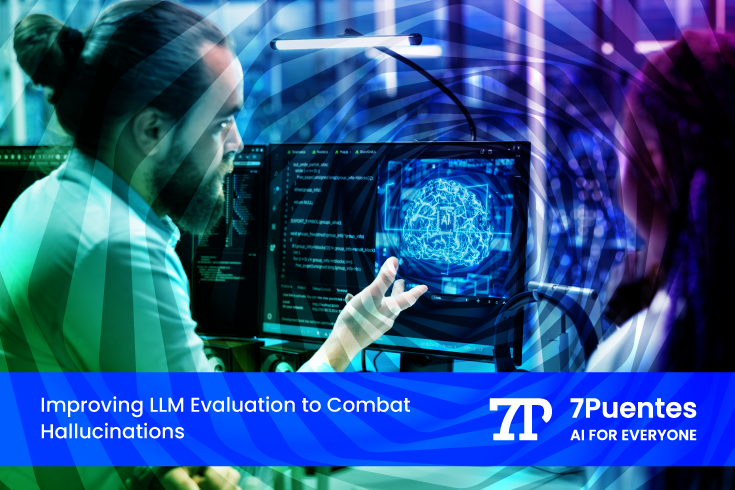LLM Assessment: Improving Evaluation to Combat Hallucinations in AI Models
Meta-description: LLM Assessment guide to combat hallucinations and AI errors. Discover robust metrics, evaluation techniques, and best practices for ensuring the reliability of your generative AI systems and language models.
Keywords: LLM Assessment, AI Hallucination Combat, LLM Reliability Metrics, OpenAI Hallucinations, Generative Model Validation, LLM Benchmarking, Training Data Quality, Large Language Models, ChatGPT Evaluation, Prompt Engineering, RAG Techniques, Machine Learning Accuracy, Generative AI Ethics, Deep Learning Models, Natural Language Processing.
Introduction: The Challenge of AI Hallucinations in Large Language Models
LLM Assessment has become a critical challenge in the era of generative AI. OpenAI recently published an article explaining why large language models (LLMs) hallucinate. And the conclusion is as revealing as it is disturbing: the problem lies not so much in the programming of the models, but in how they are evaluated and what types of tasks and data are used to train them. In this 7Puentes post, we review the most important findings and propose keys to improving the LLM assessment and reliability of generative AI models.
Hallucinations Are Not a Bug: They’re a Structural Limitation of AI Models
OpenAI, the company that drove the generative AI revolution with ChatGPT, recently acknowledged something many researchers suspected: hallucinations are inevitable (see paper published). This is not a bug that can be corrected with more data or better algorithms, but a fundamental limitation of current language models.
Hallucinations occur when the model generates plausible but false statements. They can occur even when asked simple questions. For example, when a popular chatbot was asked the title of Adam Tauman Kalai’s PhD thesis (one of the authors of the OpenAI paper), it gave three different answers… all incorrect.
Real-World Examples of LLM Hallucinations
The study also tested state-of-the-art models with surprising results. The DeepSeek-V3 model (600 billion parameters) was asked how many «D»s are in «DEEPSEEK.» The correct answer is «1,» but the model responded «2» or «3» in ten attempts. Meta AI and Claude 3.7 Sonnet also failed to get it right: in some cases, they even responded «6» or «7.»
Even OpenAI’s most recent models show increasing error rates. The o1 model hallucinates 16% of the time, while o3 and o4-mini fabricate information 33% and 48% of the time, respectively.
Why Hallucinations Are Inevitable in AI Systems
The researchers identified three main causes:
1. Lack of Reliable Training Data
When the model lacks sufficient information, it «fills in the gaps» by making things up.
2. Tasks Beyond AI Comprehension Capacity
There are problems that exceed the comprehension capacity of any model.
3. Intrinsic Complexity of Questions
There are questions so difficult that even a perfect AI could not answer them correctly.
The most important conclusion of the paper is that the problem is not just the LLMs, but how they are assessed. Nine out of ten tests penalize answering «I don’t know» and reward incorrect but reliable answers. This encourages the generation of plausible falsehoods and, consequently, more hallucinations.
Changing LLM Assessment Methodology to Improve Model Reliability
According to OpenAI, hallucinations persist because current LLM assessment metrics favor confidence over accuracy. Models are optimized to appear convincing, not necessarily correct.
The solution lies not only in better training, but in rethinking the LLM assessment of model reliability: rewarding uncertainty when appropriate, developing more humane assessments, and fostering a sociotechnical approach that combines oversight, transparency, and continuous monitoring.
In short, experts agree: completely eliminating hallucinations is impossible, but we can contain their risks through more rigorous and humane LLM assessment of generative AI.
7 Keys to Improving LLM Assessment and Understanding
At 7Puentes, we have been developing cutting-edge projects in artificial intelligence, machine learning, and web data extraction for over 15 years. With over 100 successful projects and 50 clients across multiple industries, we apply a data-driven approach that prioritizes accuracy, reliability, and ethics in the use of AI.
Based on our experience, we identified 7 key practices to improve LLM assessment and understanding:
1. Quality Training Data for AI Models
Train models with quality, pre-cleaned, and pre-evaluated data and use RAG techniques (Retrieval-Augmented Generation) to enhance the models’ understanding of the databases.
2. Parse and Structure Data for Better AI Performance
Decompose and analyze the model’s dataset to extract useful and understandable information from various sources (such as text files, HTML code, JSON, XML, and other formats).
3. Rigorously Define AI Agent Tasks
Clearly define the questions that a particular agent will answer, the data sources it will use, and the testing required to evaluate the performance of those tasks.
4. Perform Proper Prompt Engineering
Write clear and specific instructions, establish a detailed context, and iteratively test and adjust prompts to obtain high-quality results from AI models, including the intended purpose, audience, and format.
5. Reduce Biases in AI Systems
The ability to develop custom multi-agent applications, with data trained according to the needs the model must address, helps reduce the problem of biases that is widespread in any Generative AI application. These are systematic prejudices that can lead to discriminatory results, perpetuating stereotypes and social inequalities. These biases can originate in the training data (which may contain historical human biases), the design of the algorithms, the way the results are interpreted, or even the use of biased proxies.
6. Avoid Over-Reliance on AI Tools
Each tool obviously has its own limitations and must be adapted to the domain and the problem to be solved. Often, this adaptation is forced, so it is always necessary to evaluate whether the tool is truly useful for the problem being solved or whether the problem should be scaled differently.
7. Foster a Data-Driven Culture in Your Organization
Strengthening a data-driven work culture, informed decision-making, and learning data science and AI skills are pillars we uphold for any project and organization.
Conclusion: Building More Reliable AI Systems Through Better LLM Assessment
Hallucinations aren’t going away, but we can better conduct LLM assessment and manage LLMs to make them more reliable, accurate, and useful. At 7Puentes, we help companies and institutions perform thorough LLM assessment of the performance and reliability of their generative AI models, designing strategies tailored to each domain and need.
If your organization wants to use artificial intelligence agents to solve complex problems, consult with our specialists to implement a robust and ethical LLM assessment approach that maximizes the value of AI.


